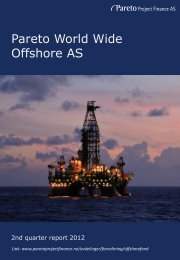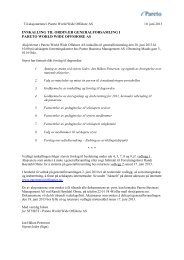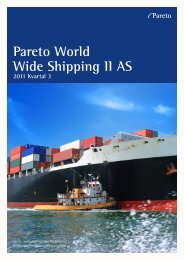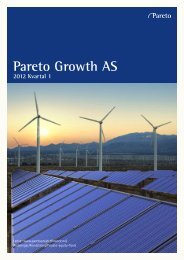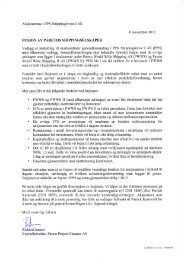Pareto World Wide Offshore AS - Pareto Project Finance
Pareto World Wide Offshore AS - Pareto Project Finance
Pareto World Wide Offshore AS - Pareto Project Finance
Create successful ePaper yourself
Turn your PDF publications into a flip-book with our unique Google optimized e-Paper software.
The offshore oil services marketThe break even oil price illusionAs can be seen in the two graphs below, offshore oilresources cost anything from USD 25/b and up to USD100/b to find, develop and produce. Outside ofNorway, most major offshore resources lie indeepwater areas and arctic areas, implying that theyare profitable at current oil price levels.The comparison with onshore oil reserves is striking.Outside of traditional OPEC production areas, onshoreoil require USD 60-100/b to break-even, i.e. they aremore costly than offshore reserves. Such reserves aretherefore likely to be drivers for an oil price increase,rather than for a lower price.One should also note that reserves like tight oil and oilsands require continuous input from activities such asdrilling, fracking and heating to stimulate flow. Theseactivities are costly, energy intensive andenvironmentally hazardous. This is very different fromconventional reserves, where the oil will flow onaccount of reservoir pressure, with only occasionalneeds for stimulation.While typical OPEC reserves have very low break-evenlevels (USD 20-30/b) and the still significant reservescan act as swing production capacity, it needs to beseen in the context of the OPEC countries budgetaryrequirements. In many cases, these countries aresovereign oil companies, where the cost of maintainingpublic services, debt service and so on, require muchhigher oil prices for the countries to break even.In this context, it is quite comforting to see that theholders of the largest oil reserves (like Saudi Arabia,Iran, Russia) require oil prices of USD 80-100/b tobreak-even. Going forward, therefore, we see USD 80-100/b as a low case range for oil prices, as this is therequirement for the swing producer. As the underlyingproduction decline starts to bite and the oil marketbecomes tighter, the marginal oil barrel will set theprice, i.e. it should move beyond USD 110/b.





